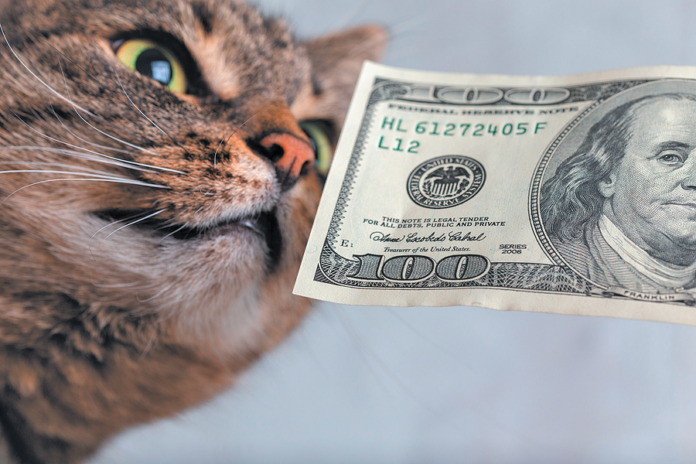Imagine a member of your household needing magnetic resonance imaging (MRI) to help diagnose a certain condition so the doctor can be sure of the right treatment, but you decide to forgo it because at $1,400, it’s too expensive; you’ll just wait and see what happens. Or picture a cat you love requiring hospitalization for three nights after an operation in order to heal as safely as possible, but you take him home after two because adding a third night would be cost prohibitive.
We see this all too often at the Tufts Foster Hospital for Small Animals. People don’t give their cats the care they need — not because they don’t want to but because they can’t afford to.
There’s a solution: pet health insurance. There has been a burgeoning of pet health insurance companies in recent years offering plans to suit a wide variety of needs and budgets. Yet only about 5 percent of pet cats in the U.S. are protected by health insurance, according to a survey conducted a couple of years ago by the American Pet Products Association.
It’s understandable, even though we view our cats as something like our children. Budgets are tight these days, and spending an extra $30 to $50 a month to protect your pet’s health — and life — in the event of an emergency is an item that’s easy to scratch off the list when the cat at issue is, at the moment, perfectly healthy.
But the best time to buy health insurance for your cat is when he is in good health. There are virtually no pet health insurance firms that will cover a pre-existing condition. Once a cat gets cancer or heart disease or needs an operation, if you don’t already have medical insurance it means that whatever you pay toward health care is going to be completely out of pocket with no reimbursement. And the appropriate care could easily reach into the thousands of dollars; cats, like people, don’t stay perfectly healthy until the day they die.
It’s optimal to buy health insurance for your pet, in fact, when he is very young — the time of life that it seems nothing could ever go wrong and the purchase of a policy feels easy to resist. We strongly suggest going against the grain of your pet’s current good health and investing in a health insurance plan. It will not only cover you in the event of an emergency. It will also lower your monthly premiums. The younger the cat, the less expensive the insurance. (And young cats, too, can develop health problems that are expensive to treat.)
What to consider when comparing plans
Choosing a health insurance plan for your cat should not take more than an hour or two — not much time for something that’s going to affect your cat’s health, and your wallet, for a decade or more. Go over the following before making a choice.
Does the plan cover a certain percentage of the total cost of care, or does it reimburse according to a benefits schedule based on maximum fees the company sets for particular procedures? If a procedure costs $2,000 but the benefits schedule says it should cost no more than $1,000, you’re going to be out a lot of money. But if the plan covers 90 percent of costs, period, reimbursement will be much greater. (Of course, your monthly premiums will also be higher, but not astronomically so.)
Always check out copays and deductibles. A lower deductible is going to mean a higher monthly premium, and vice versa. You have to determine which is the most comfortable pick for your own pocketbook.
Review age and time limitations. Some companies won’t insure a cat beyond a certain age unless they have been insuring him since he was younger. Or they won’t cover a condition for more than a certain amount of time. Such a policy might be less expensive than one that’s more comprehensive, but it could come up short in the crunch.
Make sure the company won’t drop your cat after he develops a condition that’s expensive to treat.
Be certain the policy covers diagnostic testing in addition to treatments. CT scans, MRI, even blood and urine tests, can be very expensive. The same equipment and expertise is required as for people. And the cost of these screenings adds up very, very quickly, before you even get to the treatment.
The good news when comparing policies is that there are no in-network and out-of-network providers. Companies will generally cover care by any licensed veterinarian. But you have to pay the vet up front and then get reimbursed, so you want to make sure you’re not near the limit on your credit card if you don’t have ready cash. (Or see if the vet can wait for full payment until after you submit the paperwork to the insurance company.)
The American Veterinary Medical Association lists the following companies that sell pet health insurance. They do not endorse any of them, but these are good companies to compare as you do the homework to choose the policy that will work best for your ledger.
Note: Don’t worry about whether the policy will cover routine care. That’s not the expense that’s going to wreck your budget. Go with a plan that’s going to cover something you couldn’t easily afford to treat unless you had pet health insurance. No plan will cover 100 percent of charges. But one that covers, say, 80 or 90 percent of costs could be invaluable if the treatment ends up costing $5,000 to $10,000.
➤ 24PetWatch
➤ AKC Pet Insurance
➤ ASPCA Pet Health Insurance
➤ Best Friends Pet Insurance
➤ Embrace Pet Insurance
➤ Figo Pet Insurance
➤ Healthy Paws
➤ Lemonade
➤ PetFirst Healthcare
➤ Pets Best
➤ Petplan
➤ Pumpkin
➤ PurinaCare
➤ Trupanion
➤ VPI




